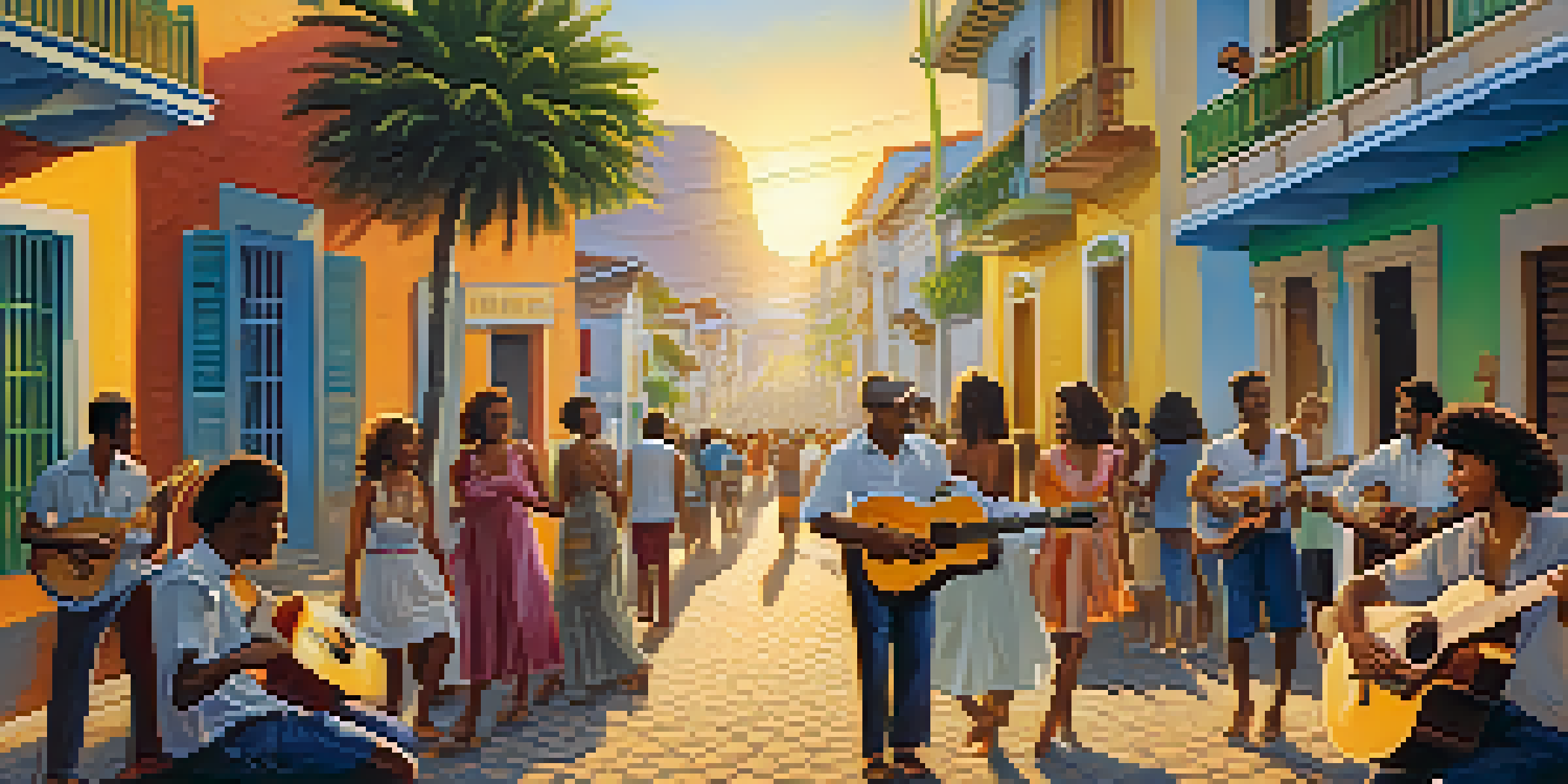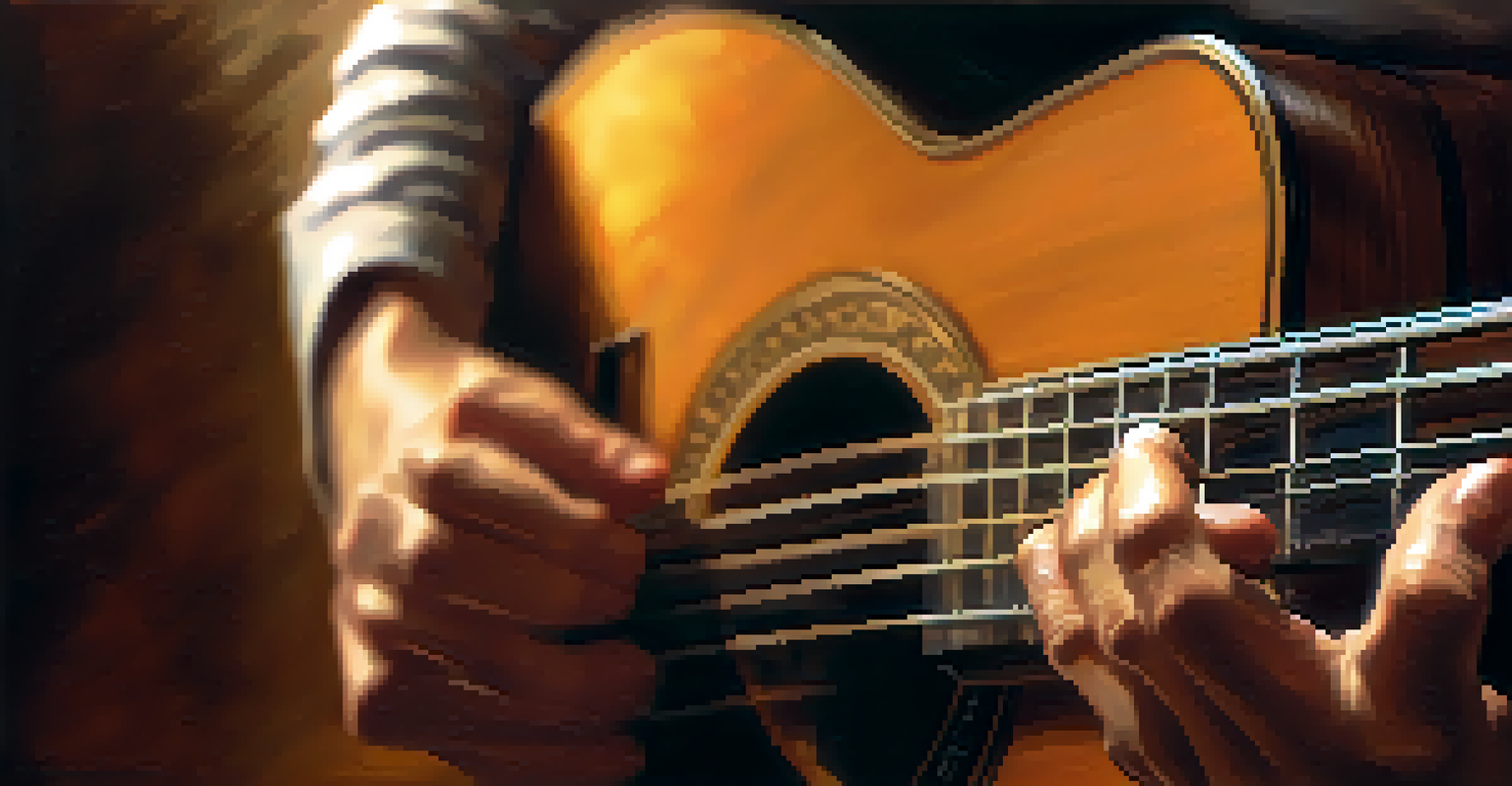Brazilian Bossa Nova and Its Guitar Melodies: A Cultural Study

The Origins of Bossa Nova: A Cultural Fusion
Bossa Nova emerged in the late 1950s in Brazil, blending samba rhythms with jazz influences. This unique fusion reflects Brazil's rich cultural heritage, where music is a vital part of social life. The term 'Bossa Nova' translates to 'new trend,' indicating its innovative approach to traditional Brazilian music.
Bossa Nova is a musical movement that reflects the heart and soul of Brazil, blending rhythms and melodies that resonate with emotions.
Key figures like João Gilberto and Tom Jobim played pivotal roles in shaping the genre. They infused their music with personal experiences and emotions, making Bossa Nova relatable to many. This cultural movement not only transformed Brazilian music but also gained international acclaim, captivating audiences worldwide.
As Bossa Nova spread beyond Brazil, it introduced new sounds and styles to global music scenes. Artists from various countries began to incorporate its elements into their work, further enriching the genre. This cross-cultural exchange is a testament to the universal appeal of Bossa Nova and its guitar melodies.
The Role of the Guitar in Bossa Nova's Sound
At the heart of Bossa Nova lies the guitar, which serves as both a rhythmic and melodic instrument. The gentle strumming patterns create a soothing backdrop, while intricate fingerpicking adds depth and complexity. This combination captures the essence of the genre, inviting listeners into a dreamy musical landscape.

Guitarists often use a unique technique called 'batida,' which interweaves bass notes with chords to create a rich harmonic texture. This distinctive style sets Bossa Nova apart from other genres and showcases the guitarist's skill. It's a beautiful dance of rhythm and melody that embodies the laid-back spirit of Brazil.
Bossa Nova: A Cultural Fusion
Emerging in the late 1950s, Bossa Nova blends samba and jazz, showcasing Brazil's rich musical heritage.
Many Bossa Nova guitarists, including Gilberto and Jobim, have left a lasting legacy with their innovative techniques. Their approach continues to inspire new generations of musicians, both in Brazil and around the world. This ongoing influence highlights the guitar's central role in shaping the genre's identity.
Key Characteristics of Bossa Nova Guitar Melodies
Bossa Nova guitar melodies are characterized by their smooth, flowing lines and subtle nuances. Unlike the more aggressive strumming found in samba, Bossa Nova emphasizes a softer, more melodic approach. This creates an intimate atmosphere that resonates with listeners, making it perfect for quiet evenings and romantic moments.
The beauty of Bossa Nova lies in its ability to convey deep feelings through simple, yet sophisticated melodies.
Another defining feature is the use of extended chords, which adds a touch of sophistication to the music. These harmonies create a lush sound that enriches the listening experience. The interplay between melody and harmony is a hallmark of Bossa Nova, showcasing the artistry of its guitarists.
The simplicity of the melodies, combined with their emotional depth, makes them accessible yet profound. This balance allows listeners to connect with the music on a personal level. Whether it’s a gentle lullaby or an upbeat tune, Bossa Nova guitar melodies evoke a wide range of emotions.
Influential Bossa Nova Guitarists You Should Know
Several guitarists have made significant contributions to the Bossa Nova genre. João Gilberto, often referred to as the 'father of Bossa Nova,' revolutionized guitar playing with his unique style. His innovative techniques and soothing voice became synonymous with the genre, influencing countless musicians.
Tom Jobim, a prolific composer and musician, is another key figure in Bossa Nova's history. His collaborations with Gilberto produced some of the genre's most iconic songs, such as 'Garota de Ipanema.' Jobim's ability to blend complex harmonies with simple melodies showcases the depth of Bossa Nova's musicality.
Guitar's Role in Bossa Nova
The guitar serves as both a rhythmic and melodic backbone in Bossa Nova, characterized by unique techniques like 'batida.'
Other notable guitarists include Baden Powell and Vinicius de Moraes, who brought their own flair to the genre. Each artist contributed to the evolving sound of Bossa Nova, ensuring its place in music history. Their legacies continue to inspire both seasoned musicians and newcomers alike.
The Global Impact of Bossa Nova
Bossa Nova's influence extends far beyond Brazil, reaching audiences around the globe. In the 1960s, the genre captured the attention of jazz musicians, who began to incorporate its rhythms and melodies into their work. This cross-pollination of styles led to a vibrant fusion of jazz and Bossa Nova that enriched both genres.
Artists like Stan Getz and Astrud Gilberto played a pivotal role in popularizing Bossa Nova in the United States. Their collaboration on tracks such as 'The Girl from Ipanema' introduced American audiences to the genre's charm. This exposure helped solidify Bossa Nova's status as a significant cultural movement.
Today, Bossa Nova continues to inspire musicians across various genres. From pop to electronic music, its influence can be heard in contemporary compositions. This enduring legacy speaks to the universal appeal of Bossa Nova and its captivating guitar melodies.
Bossa Nova in Contemporary Music
As music evolves, Bossa Nova remains a relevant influence in contemporary sounds. Many modern artists draw inspiration from its rhythms and guitar techniques, creating fresh interpretations of the genre. This blending of old and new showcases the timeless quality of Bossa Nova music.
Genres like chill-out and lounge music often incorporate Bossa Nova elements, introducing them to new audiences. The laid-back vibe and intricate guitar melodies resonate well with listeners seeking a relaxing atmosphere. This fusion allows Bossa Nova to thrive in today’s diverse musical landscape.
Bossa Nova's Global Influence
Bossa Nova's charm captivated international audiences, leading to its integration into various music genres worldwide.
Moreover, collaborations between Bossa Nova musicians and artists from other genres continue to emerge. These partnerships create innovative sounds that keep the spirit of Bossa Nova alive. As a result, the genre remains a vibrant part of the global music scene, appealing to both nostalgic fans and new listeners.
Appreciating Bossa Nova: Listening Tips
To fully appreciate Bossa Nova, it's essential to engage with its subtle nuances. Start by listening to the guitar melodies and how they interact with the vocals. Pay attention to the delicate strumming patterns and the intricate fingerpicking, which create a rich tapestry of sound.
Exploring different artists and their interpretations can also enhance your understanding of the genre. Each musician brings their own flavor to Bossa Nova, offering a diverse listening experience. Don't hesitate to delve into both classic tracks and contemporary renditions to see how the genre has evolved.

Finally, allow yourself to be immersed in the emotions conveyed through the music. Bossa Nova is not just about rhythm and melody; it's about storytelling and connection. So, find a cozy spot, relax, and let the soothing sounds of Bossa Nova transport you to the sun-kissed shores of Brazil.